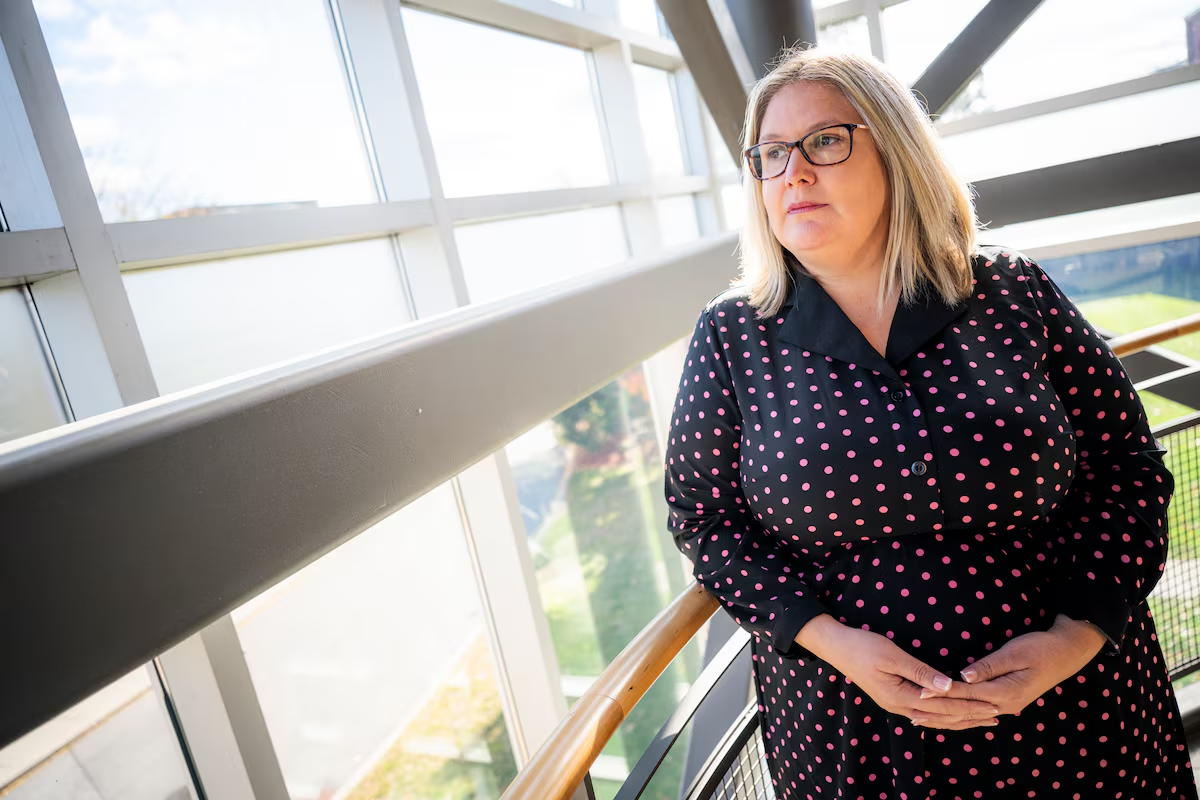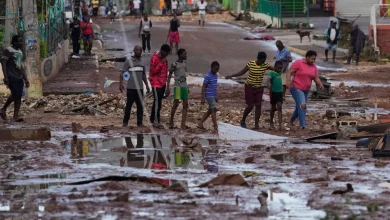Canada’s international student cap helped lower rents. But will it bring colleges and universities down as well?

Amanda Shaw has worked at St. Lawrence College’s Cornwall campus for more than a decade, long enough to have lived through the international student boom. And now the bust.
When she started, foreign enrolment was low. Then it seemed to skyrocket. The small campus on the shores of the St. Lawrence River in eastern Ontario started to bustle; the college ran budget surpluses and introduced innovative programs. Even during the chaos of COVID-19 the numbers continued to grow. The same thing was happening at colleges across the province and in other parts of the country.
Then, in January, 2024, the federal government effectively pulled an emergency brake. It announced immediate steps to reduce the number of international study permits by about 35 per cent, primarily in an attempt to cool an overheated housing market. About a dozen related policy shifts, a mix of cuts and restrictions, followed over the next 18 months. “All of a sudden the landscape changed,” Ms. Shaw said.
Nearly two years later, rent prices have come down in some cities as the number of international students has dropped. It’s easier to find a place to live. But there was a trade-off.
The decline in international students has had a devastating impact on many colleges and universities. In Ontario’s college system alone, at least 8,000 people have lost their jobs, according to figures published in a mediator’s report. Thousands more positions have been cut at postsecondary schools across the country, and hundreds of programs have been closed or suspended. What was once a $35-billion a year industry – equivalent to about 1.6 per cent of GDP – is now struggling to adapt to a new reality.
Any hope that the federal government would change course was erased last week. Prime Minister Mark Carney’s first budget announced that the number of international study permits would be cut nearly in half again, to 155,000 next year from a goal of about 306,000.
Open this photo in gallery:
Last week, Finance Minister François-Philippe Champagne unveiled a federal budget that tightens the reins even further on international study permits.Dave Chan/The Globe and Mail
Governments in Canada used to celebrate internationalization. They prodded universities and colleges to pursue foreign students as a source of funding, since they pay fees several times higher than domestic rates. When the strategy proved successful, provinces eased up on their financial support for the sector, which has been largely stagnant. The increased international tuition revenue made it possible to keep costs for Canadian students relatively low and subsidized expensive programs.
Then came the study permit cap in 2024.
The number of new international student arrivals from January through August 2025 dropped to 89,430, down from 221,940 in the first year of the cap, according to data published by the federal government.
The price has been paid most heavily in Ontario. The province, which provides the lowest level of per-student funding of any in the country, has frozen domestic tuition fees since 2019. Its 24 publicly funded colleges came to rely on international students, mainly from India, to fund operations. So far more than 600 programs have been suspended at those schools, at least two campuses have closed and between 8,000 and 10,000 jobs have been lost. The colleges say they’ve reduced spending by $1.8-billion, but the cuts to study permits announced in the latest federal budget could mean a further drop of up to $2.5-billion in tuition revenue.
At St. Lawrence College in Cornwall, the layoffs started last fall. Ms. Shaw’s team in the academic planning department was cut in half, as was the group of clerks that supports them. This year, what she calls the “hemorrhaging of jobs” has led to a huge increase in workload.
She spent five weeks on strike in September and October, a major disruption that put approximately 10,000 Ontario college support staff on the picket lines. The main issue was job security. Ms. Shaw, a leader in the local union chapter, wants to work in the college sector until retirement, but that future looks much more uncertain. “It’s hard not to think, ‘What’s going to happen to me?,’” she said.
What some see as an issue with roots primarily in Ontario has had consequences in other regions. In Saskatchewan, about a hundred employees have been laid off and 17 programs have been suspended at Saskatchewan Polytechnic, which has lost about 40 per cent of its international enrolment – a revenue drop of tens of millions. “We were able to run additional programs with additional seats for domestic students as a result of our international enrolments, and that won’t happen now,” said Larry Rosia, the school’s president. “We just don’t have the funds.”
The sector as a whole has been “devastated” by the 2024 policy changes, he added, citing a public tally kept by education consultant Ken Steele that shows more than 12,000 jobs lost across the country.
“If we were talking about any other industry – the steel industry, the auto industry, the lumber industry – it would be on the TV every night and the federal government would be stepping in to help,” Mr. Rosia said.
Many in the sector agreed that something needed to be done, he said, but government policy has ignored the need for young, skilled graduates often filled by foreign students in Saskatchewan and beyond. International grads from his school have a 96 per cent employment rate, he added.
Saskatchewan Polytechnic, whose Saskatoon campus is one of several across the province, has plans to build a new, more modern campus here. Meanwhile, it has had to cut 17 programs and fire hundreds of staff. President Larry Rosia is alarmed by the postsecondary job losses across in Canada.
Liam Richards/The Globe and Mail
The government was in such a rush to lower the number of temporary residents that it didn’t pay enough attention to who it was pushing away, said Gabriel Miller, president of Universities Canada, which represents nearly 100 Canadian schools.
“The challenge here was always to lower numbers in a smart way,” he said. “It’s a bit like they decided to go on a diet and they stopped eating vegetables.”
One measure in the recent budget that was welcomed by universities was the decision to remove master’s and PhD students at public universities from being counted against the study permit cap. That should make it easier for schools to recruit top candidates, many of whom may want to stay in Canada and should have strong prospects for high-paying employment.
“Going forward, targets will continue to be set with the objective of attracting the best and brightest international students to study at Canada’s world-class learning institutions in volumes aligned with community capacity and the economic needs of the country,” said Matthew Krupovich, a spokesperson for the Department of Immigration, Refugees and Citizenship Canada.
Education is primarily a provincial matter, he added, and those governments are responsible for allocating the study permits allotted to them by Ottawa.
But with demand down, it remains to be seen how many applicants will choose Canada over other popular international destinations, such as Britain or Australia.
Open this photo in gallery:
Cutbacks have created labour friction at some schools. Dalhousie locked out its faculty in August amid a contract dispute over wages and workload, which got settled in September.Darren Calabrese/The Canadian Press
In B.C., hundreds of postsecondary jobs have already been lost, along with millions in revenue. Unions have said the system is being decimated while the provincial government blames “abrupt” policy changes from Ottawa. Atlantic Canada’s universities recently reported that their international student numbers are down 36 per cent over two years. The loss of revenue played a role in the recent lockout of faculty at Dalhousie University in Halifax, and is hitting every university in the region.
The situation is somewhat different in Quebec, where a large number of international students at francophone universities hail from France or Belgium and pay domestic tuition rates under an agreement with the Quebec government.
Still, the decline in international students in the couple of years has been dramatic, said Christian Blanchette, president of the University of Quebec at Trois-Rivières, where about two-thirds of international students come from sub-Saharan Africa. It has cost his university about six per cent of its revenue, or $18-million, which is not easily replaced, he said.
“I think there is a housing issue across the country, yes, but the international students are not the ones creating it,” Dr. Blanchette said. “International students are an easy target.”
By late 2023 the number of international students in Canada had surpassed one million, having tripled in about a decade. That created pressure at the lower end of the housing market, where some low-income Canadians were competing with students for affordable accommodations. Rents rose steadily, encouraged by the inflationary pressure of the pandemic.
The federal government knew that housing wouldn’t be built quickly, but it could cut the number of temporary residents it was admitting. When announcing the reduced immigration levels plan in October, 2024, IRCC said the cap on student admissions would have a positive effect on housing, infrastructure and social services.
“While it’s clear our economy needs newcomers, we see the pressures facing our country, and we must adapt our policies accordingly,” said Marc Miller, the Immigration Minister at the time. “These changes will make immigration work for our country so that everyone has access to the quality jobs, homes and supports they need to thrive.”
Since 2024, rental price increases in many cities have eased, according to the Canada Mortgage and Housing Corporation. However, “it’s a two-sided story,” said Tania Bourassa-Ochoa, deputy chief economist at CMHC.
The main driver, she said, has been a jump in rental supply: This year, for the first time in four decades, more rental units were built than condos.
But it’s also clear that international student demand is down, particularly at colleges, said Anthony Passarelli, CMHC market analyst for a number of southwestern Ontario cities with large student populations (including Windsor, London, Kitchener-Waterloo and Hamilton).
“I talk a lot with the rental property operators in those areas and they all said the same thing,” Mr. Passarelli said. “There’s less competition for units.”
Sherin Sara John, an Indian international student at the University of Waterloo, said it was relatively easy to find a shared accommodation for the summer term this year. She lived with four others in an apartment near campus and paid only $800 a month, at least $200 less than the average in recent years.
“It was great,” Ms. John said. “I did enjoy that I wasn’t paying over $1,000 to live.”
Sherin Sara John, a Waterloo student from India, has two years left in her psychology studies.
Alicia Wynter/Globe and Mail
André Côté, interim executive director of the DAIS think tank at Toronto Metropolitan University, told a Parliamentary committee this fall that it’s clear the international student program had grown “a little out of control.”
There had been a huge increase in the number of foreign students, mainly in college programs, who were unlikely to go on to well-paying jobs, Mr. Côté said. And there was never going to be enough spots for all those who wanted to stay in Canada long-term, he added.
“As much as it stinks to close campuses and to lay off staff, I look at all this and say we had a system that grew far too big for its britches,” he said to the committee. “It was a bit of a reckoning that had to happen.”
Dr. Blanchette of UQTR thinks the tide may eventually turn again when governments realize the crucial role that foreign talent can play in their pursuit of economic growth.
International recruitment is important because it brings in talented people that enrich a university community, said Daniel Jutras, rector of the University of Montreal and chair of the U15 group of large research universities. “We’re bringing them in because they contribute to our research, our programs, our learning environments.”
Open this photo in gallery:
Amir Khajepour is an engineering professor in Waterloo. Finding the best students for research jobs is harder than usual, he says.Alicia Wynter/Globe and Mail
Amir Khajepour, a professor of engineering at the University of Waterloo in Ontario, says he typically has 40 to 50 graduate students and postdocs working in his lab. His research has attracted grants and industry partnerships focused on autonomous vehicles, underground mining, robotics and health care. But he’s struggling to fill available positions.
“We are not looking for just anyone. We are looking for the best students from the best universities with the best credentials,” he said.
In the last year he has accepted about 20 to 30 international applicants, but only four have been able to obtain study permits, as processing times have increased, he said, adding his lab is down to about 30 students.
Prof. Khajepour said he doesn’t understand why the government was previously unable to distinguish between top students coming to attend prestigious universities and people whose primary purpose is immigration.
“You are damaging research. In Canada, you are in a good position to attract the best. You are not even using this opportunity,” he said.
Prof. Khajepour and his students are continuing their research into autonomous vehicles, despite having fewer people in the Waterloo lab than he would like.
Alicia Wynter/Globe and Mail
Higher education: More from The Globe and Mail
The Decibel podcast
Women make up about 60 per cent of university enrolment in 2025, and that gender imbalance is not new: It’s been widening for decades. Why? Postsecondary reporter Joe Friesen spoke with The Decibel about why fewer men are in higher education, and what schools could do to lure them back. Subscribe for more episodes.
More from Joe Friesen
Hot takes and hot tips at McMaster help ease newcomers into campus life
TMU president marks milestone of opening a new medical school
For some of Canada’s prestigious programs, mid-90s grades are not enough





